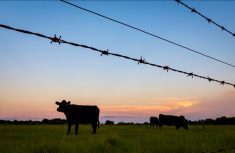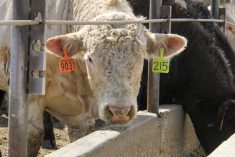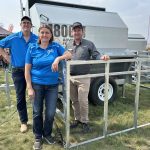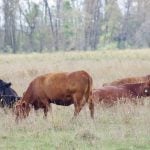Wholesale beef values have experienced a significant rally over the past couple of weeks, which has spilled over into the fed cattle trade. Alberta packers were buying fed cattle at $274 on a dressed basis, up $2-$4 from week-ago levels.
Despite the strength in the fed cattle and healthy margin structure, Western Canadian feeder cattle prices were relatively unchanged from last week. Stronger buying interest was noted on shorter-keep cattle. Reports from the country stated a larger volume of high-quality backgrounded cattle are selling direct off-farm to finishing feedlots. This has tempered activity in the auction rings, where quality is unknown and flesh levels can be deceiving.
Read Also

U.S. livestock: Cattle futures higher on screwworm news
Chicago | Reuters – Chicago Mercantile Exchange live cattle futures closed higher on Monday after news that New World screwworm,…
In southern Alberta, weight gain-controlled lower-flesh 850-lb. steers were actively moving from $163 to $165 off-farm; sales of larger-frame, medium- to lower-flesh steers were quoted from $160 to as high as $166 in central Alberta. Mixed heifers with lower flesh levels traded just above $150 in the same region.
Feedlot margins are quite healthy but there is concern for the summer time frame with the August live cattle futures trading at a $14 discount to the April contract. Long-time weaned calves were relatively unchanged in Alberta but in Saskatchewan and Manitoba, lighter-weight feeders were $2-$4 above week-ago levels. Mixed larger-frame tan steers from 600 to 625 lbs. were quoted from $200 to $204 in central Saskatchewan.
Feeder cattle exports to the U.S. have been quite dismal; nevertheless, the weaker Canadian dollar tends to influence eastern markets more than in Alberta. Pasture conditions will be optimal this spring and there appears to be rejuvenated interest from the mixed farmer/cattle producer. Feedlots also want some ownership of these lighter cattle even if they’re in a backgrounding lot for the next 150 days. Auction numbers in Saskatchewan and Manitoba have been disappointing so far this year, so there are ideas the 2016 calf crop may be smaller than earlier projections.
I still feel this feeder market has some breathing room to move higher. The beef complex from the wholesale trade to finishing feedlot has turned quite favourable in a short amount of time. We could see some sizeable week-over-week increases in the feeder market as finishing feedlots liquidate a large volume of fed cattle over the next month.
— Jerry Klassen is manager of the Canadian office for Swiss-based grain trader GAP SA Grains and Produits. He is also president and founder of Resilient Capital, which specializes in proprietary commodity futures trading and commodity market analysis. Jerry owns farmland in Manitoba and Saskatchewan but grew up on a mixed farm/feedlot operation in southern Alberta, which keeps him close to the grassroots level of grain and cattle production. Jerry is a graduate of the University of Alberta. He can be reached at 204-504-8339.
















